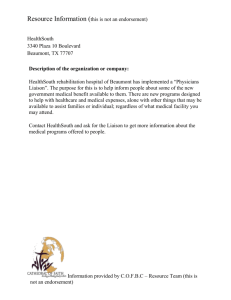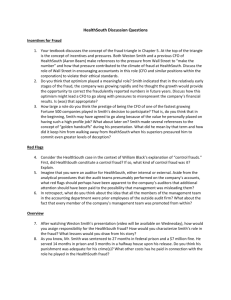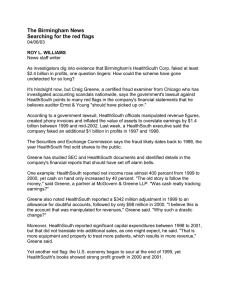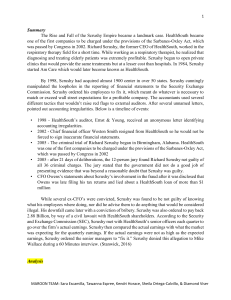HealthSouth: A Case Study in Corporate Fraud
advertisement
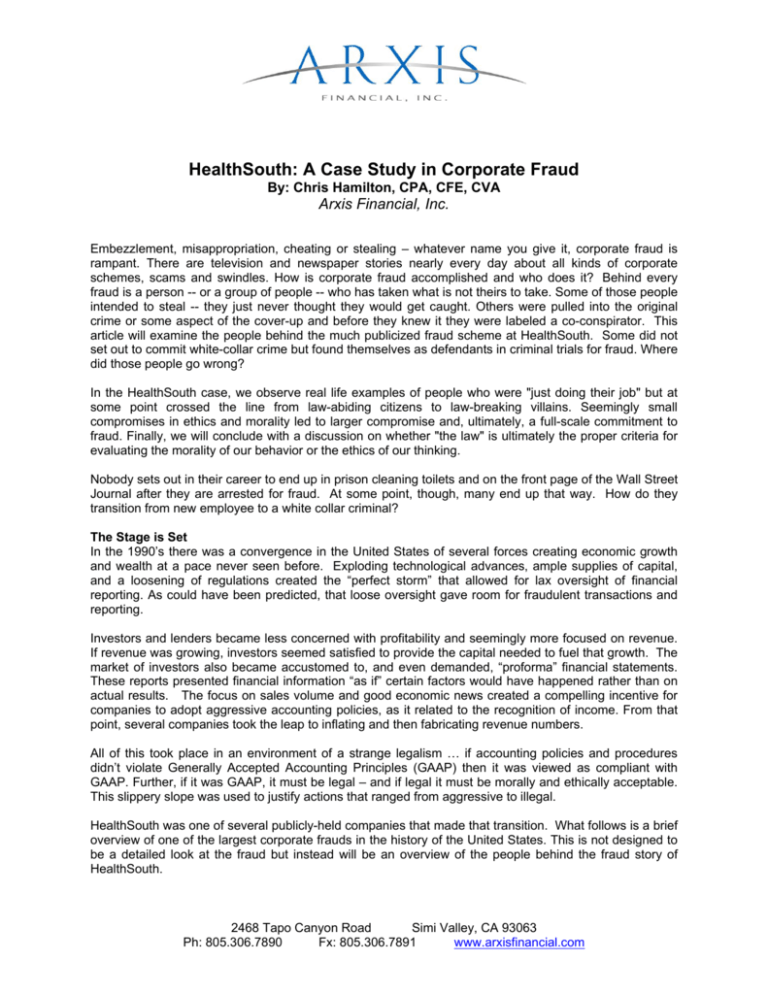
HealthSouth: A Case Study in Corporate Fraud By: Chris Hamilton, CPA, CFE, CVA Arxis Financial, Inc. Embezzlement, misappropriation, cheating or stealing – whatever name you give it, corporate fraud is rampant. There are television and newspaper stories nearly every day about all kinds of corporate schemes, scams and swindles. How is corporate fraud accomplished and who does it? Behind every fraud is a person -- or a group of people -- who has taken what is not theirs to take. Some of those people intended to steal -- they just never thought they would get caught. Others were pulled into the original crime or some aspect of the cover-up and before they knew it they were labeled a co-conspirator. This article will examine the people behind the much publicized fraud scheme at HealthSouth. Some did not set out to commit white-collar crime but found themselves as defendants in criminal trials for fraud. Where did those people go wrong? In the HealthSouth case, we observe real life examples of people who were "just doing their job" but at some point crossed the line from law-abiding citizens to law-breaking villains. Seemingly small compromises in ethics and morality led to larger compromise and, ultimately, a full-scale commitment to fraud. Finally, we will conclude with a discussion on whether "the law" is ultimately the proper criteria for evaluating the morality of our behavior or the ethics of our thinking. Nobody sets out in their career to end up in prison cleaning toilets and on the front page of the Wall Street Journal after they are arrested for fraud. At some point, though, many end up that way. How do they transition from new employee to a white collar criminal? The Stage is Set In the 1990’s there was a convergence in the United States of several forces creating economic growth and wealth at a pace never seen before. Exploding technological advances, ample supplies of capital, and a loosening of regulations created the “perfect storm” that allowed for lax oversight of financial reporting. As could have been predicted, that loose oversight gave room for fraudulent transactions and reporting. Investors and lenders became less concerned with profitability and seemingly more focused on revenue. If revenue was growing, investors seemed satisfied to provide the capital needed to fuel that growth. The market of investors also became accustomed to, and even demanded, “proforma” financial statements. These reports presented financial information “as if” certain factors would have happened rather than on actual results. The focus on sales volume and good economic news created a compelling incentive for companies to adopt aggressive accounting policies, as it related to the recognition of income. From that point, several companies took the leap to inflating and then fabricating revenue numbers. All of this took place in an environment of a strange legalism … if accounting policies and procedures didn’t violate Generally Accepted Accounting Principles (GAAP) then it was viewed as compliant with GAAP. Further, if it was GAAP, it must be legal – and if legal it must be morally and ethically acceptable. This slippery slope was used to justify actions that ranged from aggressive to illegal. HealthSouth was one of several publicly-held companies that made that transition. What follows is a brief overview of one of the largest corporate frauds in the history of the United States. This is not designed to be a detailed look at the fraud but instead will be an overview of the people behind the fraud story of HealthSouth. 2468 Tapo Canyon Road Simi Valley, CA 93063 Ph: 805.306.7890 Fx: 805.306.7891 www.arxisfinancial.com Earnings Inflation Becomes Standard Practice HealthSouth is one of the nation's largest healthcare services providers, with locations nationwide. Earnings at HealthSouth were overstated by anywhere from $3.8 Billion to $4.6 Billion over several years. This false information drove inflated market values for the firm, which attracted more capital investment. That capital flowed in from individual investors as well as institutional money. Once the market value was exposed as inflated by fraud, thousands of investors lost money as the price of the stock collapsed. The story of how the books were “cooked” involves several people and simple methodology. In short, top company officials reviewed quarterly unpublished financial results and compared the results to market expectations. If they were short, managers were ordered to “fix it.” Accounting staffers then held “family meetings” to manipulate the results which they called “filling the gap.” Staff (“family members”) then made false entries inflating assets and income. Finally, false documents were created to hide the false entries. Management knew that the auditors automatically looked at any transaction over $5,000. Therefore, company employees would only move small amounts of money at a time - between $500 and $4,999. To give some perspective on the massive amount of work involved to commit this fraud, consider that income for HealthSouth was overstated by almost $5 Billion. If the average journal entry was $2,500 to avoid auditor detection it would have required in the neighborhood of two million journal entries and all the documentation to support the fabricated entries. This volume of work was a clear indication that the participation and knowledge of the fraud was widespread within the company. At the end of the investigation, it seemed everyone knew about it except the auditors. An Honest Bookkeeper Michael Vines, a bookkeeper with HealthSouth, tried to warn several members of management about how the asset-management division was recording transactions. He was one of three employees overseeing the purchase of equipment. He came to believe that the assets were being fraudulently overstated on the company’s balance sheet. He told his immediate supervisor, Cathy Edwards, that he would not make such entries unless she first initialed them. She signed off on the entries and Vines posted them. Mr. Vines justified his participation in the fraud by forcing someone else to take the responsibility for his actions. He also reports that Edwards falsified invoices to support some of the entries in response to an inquiry by the auditors. Mr. Vines resigned from his position at HealthSouth and found another job. After resigning, he sent an email to the auditors informing them of the fraudulent entries. He identified three specific accounts that they should look at. The auditors called the CFO of HealthSouth who said Vines was a disgruntled employee. Based on that response, and satisfied with the responses to the other inquires (lies) the auditors closed the file on the audit. The Assistant Controller and Controller Cross the Line An Assistant Controller at HealthSouth, Ken Livesay would download the company’s true earnings into his computer, figure out how much adjustment (fraud) was needed to meet analyst’s earnings expectations, and pass along the figures to two superiors in the Finance department. Livesay justified his participation in the beginning because his boss promised the fraud was temporary (one time) and would end and get corrected. However, he went from a disapproving participant to a willing and committed participant. “At some point in 1996 we crossed the line… We crossed the line from gray to black.” Mr. Livesay said, “I made a lot of money as a result of my actions.” His penalty for participation was six months house arrest and a return of the money he made - $760,000 in criminal forfeitures and fines. Hannibal “Sonny” Crumple, VP & Division Controller for HealthSouth was a willing participant from the beginning: He attended meetings where the “gap” would be identified. He would leave the meetings with a homework assignment to find where to put the fraudulent postings. Once the co-conspirators would 2468 Tapo Canyon Road Simi Valley, CA 93063 Ph: 805.306.7890 Fx: 805.306.7891 www.arxisfinancial.com identify places to hide the fraud he would give the staff accountant’s fake journal entries to put on the company’s books. The accountant’s had to post thousands of entries per quarter. By the time Crumpler quit attending the meetings, the total fraud had reached $300,000,000. He was no longer in the meetings because he moved to an affiliated company called Source Medical to “make a clean break.” However, he was extorted into participation in an additional broader scale fraud. While at lunch with CFO of HealthSouth (his former boss) Crumpler was threatened that if he didn’t assist HealthSouth the whole fraud would be exposed and his role would be exposed. As a result, he sent HealthSouth auditors a letter overstating Source Medical’s debt to HealthSouth by $20 Million. This was done to help HealthSouth document the ongoing fraud with false justification. Mr. Livesay was sentenced to 8 years in prison and a fine of $1.4 Million. In the HealthSouth fraud investigation, nobody was sentenced to more time in prison than Mr. Crumpler. Chief Financial Officer Unwilling to Speak Out Aaron Beam was the CFO when the fraud at HealthSouth was initiated. The trajectory of his career, by his own admission, was that he went from earning $500,000 per year to scrubbing urinals in prison. Early in his career at HealthSouth, Beam nearly lost his job. He was interviewed by media and was quoted as saying something negative about the company. Richard Scrushy (the CEO and his boss) didn’t like it. Scrushy warned him never to say anything negative about the company again. Beam never forgot that. Beam now says that in the early days the company was aggressive and even deceitful at times. For example, instead of expensing start-up costs they capitalized them. “It started a trend. Scrushy saw you could change the numbers” and get away with it. Well, so did Beam. It started small. Nobody caught them – they got away with it! From his early career working for Scrushy, Beam had learned that he should never question or criticize his boss if he wanted to keep his job and that financial results could be manipulated without discovery or negative consequence. These two factors set the stage for one of the largest frauds in the history of corporate America. In 1996 the fraud started in earnest. Using 2,000 ledgers throughout the company a series of entries were made to cover a $50,000,000 shortfall. Beam thought the entries would get fixed. That, along with the fear of reporting anything negative about the company “robbed him of any courage or moral strength to oppose the move.” “I let myself sip into agreeing to commit fraud.” Summarizing the guilt that accompanied the activity he said, “Your whole perception of yourself, once you start living a lie, you don’t have a good feeling about yourself.” The consequences of his involvement included three months in prison, $285,000 in criminal fines and forfeitures, and legal fees in excess of $750,000. There was a degree of leniency in exchange for his testimony against Richard Scrushy. Michael Martin, who succeeded Mr. Beam as the company’s CFO and as the director of massive fraud, summed up his involvement, “I only have myself to blame for where I am standing.” He apologized to those who had suffered. “I committed a very serious crime and I am prepared to face the circumstances.” Those consequences included a three year prison sentence and $2,450,000 in fines and penalties. The Chief Executive Officer Ringleader Richard Scrushy, as has already been documented, was the ringleader. Everyone below him either plead guilty or was convicted and testified against him. The result is that he was convicted and sentenced to prison. 2468 Tapo Canyon Road Simi Valley, CA 93063 Ph: 805.306.7890 Fx: 805.306.7891 www.arxisfinancial.com On June 28, 2007, Scrushy was sentenced to 82 months in federal prison, three years probation, $267,000 in restitution and a fine of $150,000. He was also ordered to perform 500 hours of community service. An appeal bond was denied, and Scrushy was taken into immediate custody following sentencing. He is currently in the satellite camp of the U.S. Penitentiary in Beaumont, Texas. CONCLUSIONS There are many lessons that could be drawn from the story at HealthSouth. Most of the lessons are obvious – so obvious that one wonders how they all could have been missed. • • • • • The audit function is important. However, a management team that is intent and unified in its attempt to override the audit can easily do so. Collusion among several members of management makes the commission of crimes almost impossible to stop and difficult to catch. Small concessions lead to greater compromises and, unchecked, will lead to serious ethical lapses and even crime. As detailed above, nobody sets out to end their career in prison. Several people from HealthSouth in fact did end their career that way; it all started with small, seemingly insignificant, compromises. Personal morality and ethics make up the collective morality and ethics of a corporation. Very often, in the media, companies like HealthSouth are described as a monolithic entity that has a life of its own. In reality, as the HealthSouth story illustrates, the culture of the company is simply the sum total of its leadership and employees. Any of the people described here could have refused to participate in the fraud and could have stopped, or severely impaired, the widespread operation to commit fraud and then cover it up. A legal or ethical compromise opens up the possibility of that original compromise being used as blackmail to participate further. Mr. Crumpler’s story is an illustration of the continuing leverage of a criminal enterprise once there has been participation. It is perhaps the most insidious pathway from a “mistake” to criminal involvement. Finally, one would hope that a lesson from HealthSouth and all the other corporate white collar crime cases from the late 1990’s is that fraud will be caught and it will be punished. HealthSouth as a company is alive and well today. The lives of those who committed the fraud have largely been destroyed. None of that is comfort to the thousands of employees and investors of HealthSouth who lost significant portions of their life savings due to the theft and deceit of relatively few people. Chris Hamilton is a partner with the CPA firm of Arxis Financial, Inc., in Simi Valley. He can be reached at ph. 805-306-7890 or chamilton@arxisgroup.com. 2468 Tapo Canyon Road Simi Valley, CA 93063 Ph: 805.306.7890 Fx: 805.306.7891 www.arxisfinancial.com
